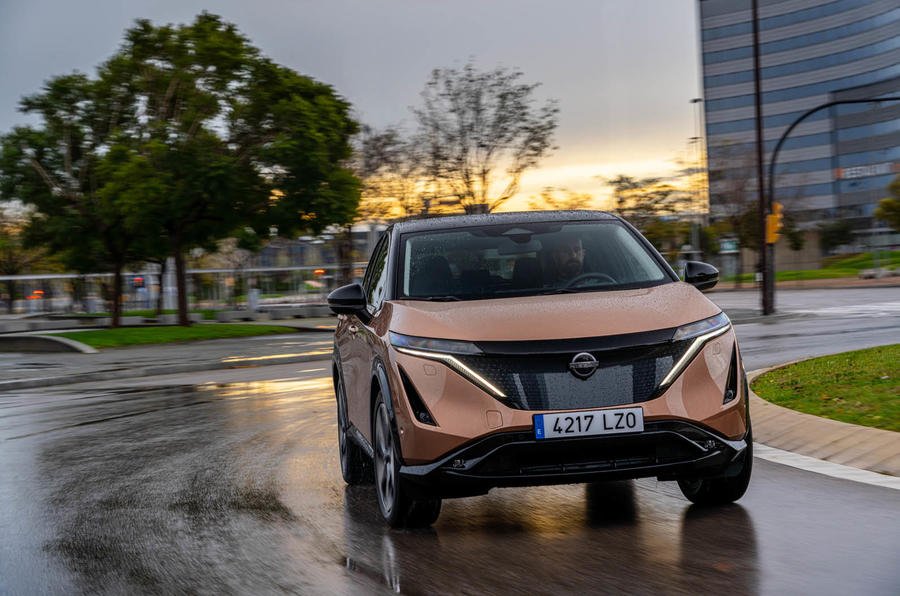New 2022 Nissan Ariya: flagship EV priced from £41,845

The new Nissan Ariya electric SUV features bold styling, a range of up to 310 miles and a 389bhp performance variant – and Nissan claims it will “mark a new era for electric vehicles” by combining high levels of tech with “exciting” handling.
Pre-orders for the Volkswagen ID 4 rival are now open, ahead of first deliveries beginning in summer, with prices starting from £41,845 for the entry-level Advance car, with front-wheel drive and a 63kWh battery.
That car is capable of a claimed 223 miles on the WLTP cycle, while its 215bhp motor sends it from 0-62mph in 7.5 seconds.
The larger 87kWh battery is available from £51,090 with a more potent 240bhp 2WD powertrain – for a range of 310 miles – or £53,790 with the e-4orce four-wheel-drive powertrain, which can be had with either 302bhp or, in range-topping, £58,440 e-4orce Performance guise, 389bhp.
The e-4orce Performance model can cover 0-62mph in a claimed 5.1sec and, like the other e-4orce models, has a top speed of 124mph (25mph more than the single-motor cars).
The production-ready Ariya retains the bold styling of the concept unveiled at last year’s Tokyo motor show and showcases Nissan’s new brand identity with “seamless, elegant and fresh” styling. It shares the Renault-Nissan-Mitsubishi Alliance’s new CMF-EV electric architecture with the smaller Renault Mégane E-tech Electric, and Nissan operating chief Ashwani Gupta said it represents the start of “a new chapter for Nissan”.
He said the firm has “strived to amplify the fun-to-drive aspect of electric mobility,” adding: “It’s not just a great EV crossover, but also a great vehicle – a true force of wonder that will take us into the future.”
Nissan’s new e-4orce four-wheel drive system is referred to as the “spiritual offspring” of the system used in the GT-R supercar. It employs a regenerative rear-motor braking system to minimise vehicle pitch and smooth the ride.
The Ariya gets Standard, Sport and Eco driving modes, with e-4orce variants adding a Snow mode. Nissan claims the underfloor battery has been positioned to ensure 50:50 front/rear weight distribution, with flat underbody aerodynamics to boost stability. It also uses the Leaf’s e-Pedal regeneration system, allowing one-pedal driving.
Makoto Fukuda, the Ariya’s development chief, said the focus wasn’t just on achieving rapid acceleration but also on providing “maximum, usable performance in a wide range of driving conditions”.
The Ariya is 4595mm long, 1850mm wide and 1660mm tall, with a 2775mm wheelbase. That makes it virtually the same size as VW’s forthcoming ID 4 electric SUV. The Ariya’s weight ranges from 1.8 to 2.3 tonnes, depending on spec.
The front of the car features a new ‘shield’ design and has a 3D ‘kumiko’ pattern under a smooth surface. In markets that allow it, the Nissan logo will be backlit with 20 LEDs. The side profile has a low-slung coupé roofline, with a single, horizon line linking the front and rear of the car. The back end has a distinctive C-pillar design, a high-mounted rear wing and a one-piece light bar. The Ariya rides on 19in or 20in wheels and has multi-link rear suspension.
The minimalist interior is similarly bold, with virtually all physical buttons replaced by capacitive, haptic-feedback switches built into the dashboard surface. A fold-out centre storage box is sited under the main instrument panel. There are also ‘Zero Gravity’ slim-profile seats, a 12.3in central touchscreen, a 12.3in digital driver display and what Nissan says is one of the largest full-colour head-up displays in the class.
The Ariya will also be offered with a high level of driver assistance systems, including an enhanced version of the Leaf’s ProPilot system, with lane-keeping assistance and adaptive cruise control. Nissan’s Safety Shield active safety systems are standard.
The Ariya has a new voice control system and owners can use a Nissan smartphone app to check battery status and set climate controls remotely. Built-in 4G connectivity allows over-the-air updates, too.
The 63kWh cars will get a 7.4kW home charger, with 87kWh cars featuring a 22kW three-phase charger. There’s also a 130kW rapid-charger.
